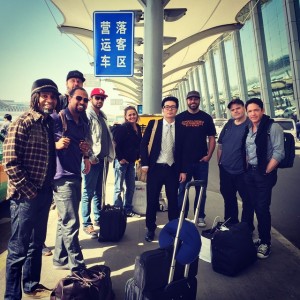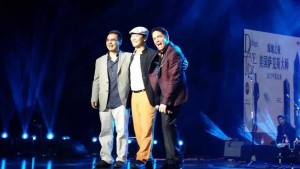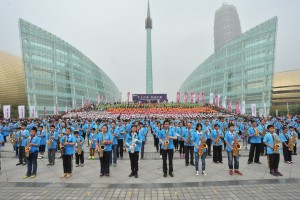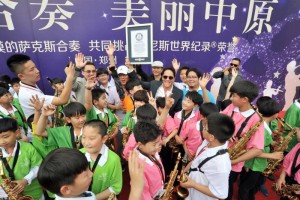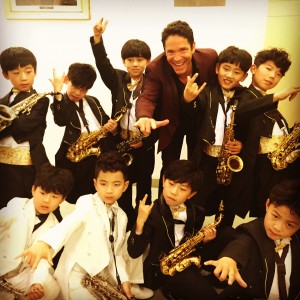
Dave Koz with kids in Zhengzhou, Henan – all images supplied by Koz’s Chinese representative, no copyright infringement intended
Where will a new jazz audience arise? How about China? Not only have plans been announced to open a Blue Note Jazz Club in Beijing — since 2012, Hong Kong-based entrepreneur Jason Lee has helped pave the way by booking big name and somewhat lesser-known instrumentalists for tours reaching into “second tier cities” (populations between three and seven million) across the vast country. Lee’s most recent import was Billboard chart-topping, oft-Grammy nominated, 25th-year-of-career-celebrating contemporary jazz saxophonist Dave Koz.
“I don’t know if I’ll ever fully recover from my first time in mainland China,” says  Koz, who performed five concerts in nine days last May in front of crowds averaging about 1000 — and helped establish a Guinness World Record for the Largest Saxophone Ensemble ever convened to perform, with 1867 uniformed student players blowing on “Auld Lang Syne.”
“It was an adventure, to say the least,” the 52-year old Koz continues. He seems to be an adventurer by nature, having among other distinctions been a syndicated radio and television show host, running his own cruise company and leading The Emeril Lagasse Show band (Dave Koz’s Kozmos). “We operated with the pioneer spirit – saying ‘Whatever we encounter, we’ll face it with a smile.'”
He reports that the tour with his Los Angeles-based quintet, support staff of three and Chinese guest artists was almost all smiles. “I had no expectations because I’d never been there and had no deep information about what to expect in advance,” he says. “In two or three cities it became clear to us — and we said to each other — that we were the first American jazz musicians ever there.”
Like many jazz musicians, Koz is a seasoned traveler. He cites no hardships, speaking only of good food and warm encounters with generous local people. His troupe eased into action attracting some 300 attendees to a free promotional q&a session in Tsinghua University with the help of Du Yinjiao (“Mr. Du”), chairman of the China Saxophone Association and organizer of widespread sax “clubs” advancing adoption and appreciation of the instrument. A player of the entire sax family who guested on tenor at most of the tour’s stops, Mr. Du is, according to Koz, “a soft-spoken man, probably in his early 50s. I got to know him through the music.”
Their first date was 400 miles southeast of Beijing, appearing for an audience of about 1000 in a banquet hall in Zhaoyuan (considered a “third tier” city) in Shandong. Then Koz and co. flew 500 miles southwest to Zhengzhou, Henan for the daytime sax convention and evening concert for 1000 at the Grand Theater; 300 miles almost due west to Xian, Shaanxi for an auditorium packed with another thousand listeners; 450 miles north by northwest to Yinchuan, Ningxia for a slightly smaller (900) audience in another auditorium; 275 miles south by southwest to a blues and jazz club/restaurant holding some 250 people in Lanzhou, Gansu, and about 1000 miles from that center of China back east to Beijing.
Koz been turned on to this opportunity by guitarist Chieli Minucci of Special EFX, which Lee brought to China in 2012.Ramping up  efforts he’d begun around 2000, Lee introduced Lee Ritenour to the country in 2013, and John McLaughlin in 2014. He’s also brought over saxophonist Antonio Hart and violinist Christian Howes, and scheduled upcoming tours for tenor saxophonist Sean Nowell, pianist Lynne Arriale and guitarist Nir Felder.
“Jason was our promoter representative over there,” Koz says. “His operating strategy was to go in from a saxophone perspective, instead of promoting me as a pop or jazz artist. The saxophone is incredibly popular all across China.  At least 50 per cent of the audience was saxophone-playing kids and their parents. It’s a great shot in the arm to see how the youth are embracing the instrument. People have a little money now; it’s an ancient country but feels brand new, too. People have means where they didn’t have it before. For young adults having kids, their socialization requires that the kid take up musical instrument. It may be violin, guitar, piano, but most often the choice is a sax.”
Koz has just issued Collaborations: 25th Anniversary Collection, an anthology of performances with notables including Stevie Wonder, Herb Alpert, Rod Stewart, Luther Vandross, Stevie Nicks, Keb’ Mo’ and Barry Manilow. In China his collaborators besides Mr. Du included mainland player Dong Yao and Simon Wu, a younger (mid-30s) player from Shanghai.
“They have their own style of playing,” Koz acknowledges. “Chinese music has a different vibe. The saxophone is obviously not indigenous to that region – and interestingly, the basic tuning is different. Wu and Du play the Chinese tuning that’s not A = 440; their standard is a little sharper. Their music feels very authentic – they are very emotional players, putting a lot of heart into it, so the music feels intense and deliberate. We did some Western and some Chinese music together. To do so, I tried to get in their heads, and vice versa.”
It was at least as daunting to meet the regiment of saxophonists with whom he performed in Zhengzhou.  “I didn’t understand what was happening until I saw it,” he recalls. “Nearly 2000 sax players, all wearing matching outfits and laminates with my picture on it! Because of our coming to town they were going to try to set a new Guinness World Record playing a song together –- and they did! This is one of the sweetest things I’ve ever experienced. They played a Chinese song as well as ‘Auld Lang Syne,’ and produced a sound never heard before with that many sax players. It was beautiful, it touched me so deeply that something like this would take place in front of me. And a lot of those kids came to our show that night.
“In the U.S. we’ve seen it all, done it all – things have to be so shocking to register — but to be surrounded by kids and in China, with everything new, being discovered, there’s an innocence and simplicity in that. Throughout, Mr. Du and Simon Wu were always observing us, as if taking notes. They were embracing Western culture to learn about what might stick.
“Of course they have their own rich culture, thousands of years old. And communication could be difficult. There was not a lot of English being spoken, and much as I try to learn languages when I travel, I found Mandarin just about impossible. That said, there’s no doubt in my mind that mainland China will be a place many, many American artists will go to play. They’ve spent a long time listening to Western music -– Kenny G is bigger there than sliced bread. They’re listened to a lot of other American sax players, too, taking from them what they feel good about, adding their own flavors for a sound that feels right in the pocket for that market.
“It’s such a difference — such a huge country with such a huge population, four or five billion — that there are regional differences, just like here. But there are great opportunities everywhere. It wasn’t all easy. There were days we didn’t know if we were going to have a show because of unexpected issues arising about the venue or the equipment. Still, overall, we had a great, great time. And people knew my music! I never expected that. Kids knew my music, seven- and eight-year-olds! That was mind-boggling.”
Having established a base for Koz, Jason Lee is eager to have him return. “We’re talking about maybe go back once a year,” the saxophonist says. “We did something similar in Japan, and got great results from the effort. Once we started to go, in 2004 or 2005, it became an open door for us and we’ve developed a wonderful relationship with audiences in the country. This May trip also took us to Jojakarta, Indonesia, where I’ve been going for 20 years. They have the Java Jazz Fest there in March annually. It’s one of the biggest fests on the planet, attracting all young people for entertainment by international acts.
“It’s amazing to see how popular our music is outside the U.S.,” Koz muses. “What we encountered was sometimes inspiring, sometimes difficult, sometimes otherworldly. But that’s the beauty of music: that it can take you around the world.”
Subscribe by Email |
Subscribe by RSS |
Follow on Twitter
[contextly_auto_sidebar id=”DwQp4BE3sVGZHPJqsQESzdz0TZT46SNd”]

